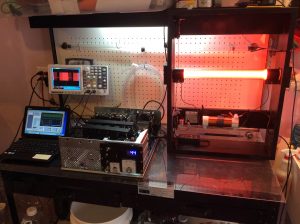
Home built Rife machine that occupies an entire work bench
To build a working Rife machine you need 3 main components.
1) A frequency generator to create the right frequency to kill the pathogen.
2) An electronics system which accepts the audio input and uses it to modulate an RF carrier and then amplifies it for output to the plasma tube.
3) A plasma tube which serves as an antenna to radiate the RF signal to penetrate the body and deliver the audio signal.
For 1) I use a laptop computer with built in sound card plus a software package called Frex16 but you can use any suitable audio source including a GB4000 or Spooky2. Frex16 has a built in database of MOR frequencies for numerous pathogens from the CAFL list and other sources. It only cost about $60. So, if you already have a computer and sound card it’s a very inexpensive option.
For 2) I use an SPA4 card from Spectrotek. Their website has a wealth of information on how to build a system. Start there to learn more. I built the DC power supply using 7 laptop chargers as described on the site. They have a newer card called the SPA5 that is easier to work with but has less operational flexibility.
For 3) I used a plasma tube from Bill’s Plasma Tubes. I used a SSQ-ST 20” tube for my first system and a SST-BAT 30” tube for my second.
I’ve had some difficulties with the 30” tube. It’s large so it is more fragile. The first one arrived broken in shipment. The second arrived okay but it requires a lot more power than the 20” so it pushes the amp a lot harder. I have had problems with it blowing the output transistor on the SPA4. I’m getting some RF noise in the audio input that I’m trying to track down that I think is the culprit. For someone building their first system I would recommend going with the 20” tube. The 20” tube is more powerful than any commercial units I have seen specs for. It runs at about 175 watts average power, 350 watts peak. It is $200 cheaper and is smaller and less expensive to ship than the 30”. It’s less fragile. The 20” doesn’t push the system as hard so there is more margin for error. It also uses a smaller diameter coax which is much easier to work with.
My parts cost for the 20” system was about $1,200. If you have a good understanding of electronics and electronics assemble it is not a difficult build but there are a lot of bits and pieces involved. It can be tedious and time consuming. It also helps if you have some basic carpentry skills to build the stand for the plasma tube and related components.
Contact Info
http://spectrotek.com
318 527-6766
Ralph Hartwell emgineering@spectrotek.com
Bill’s Plasma Tubes
billsplasmatubes.com
855-538-4992 or
email
bill@billsplasmatubes.com.
Computer SW
frex.com.au
[Note: We are not medical doctors. We do not diagnose medical illnesses or prescribe any medical treatment. Please consult your doctor before starting any course of therapy.]
